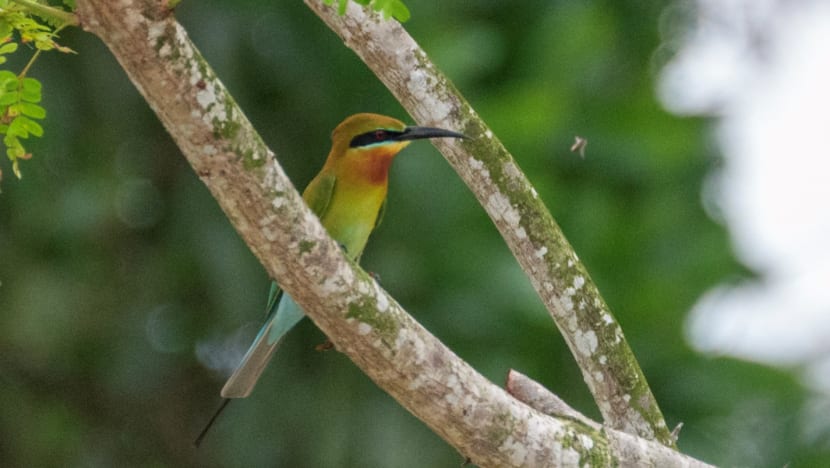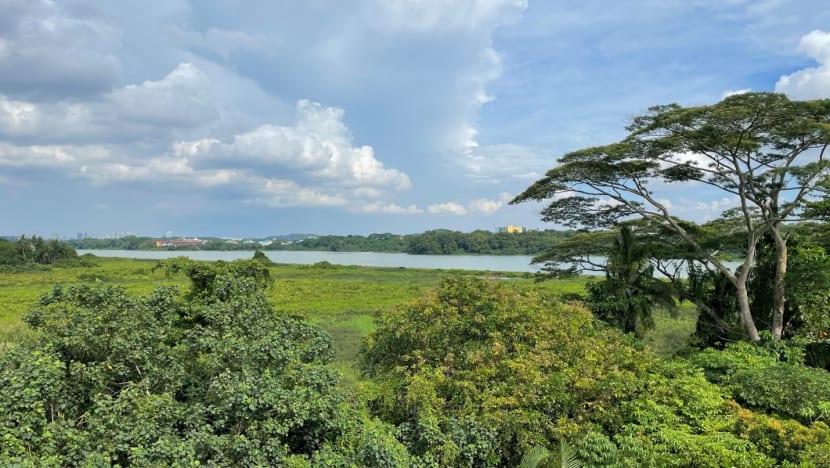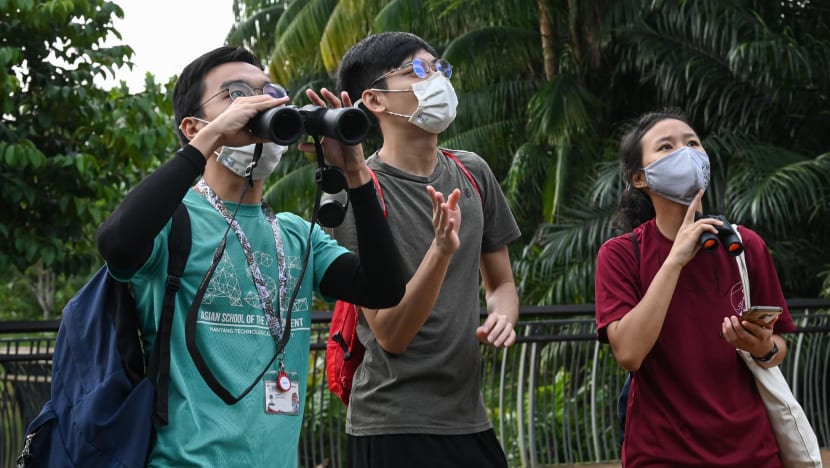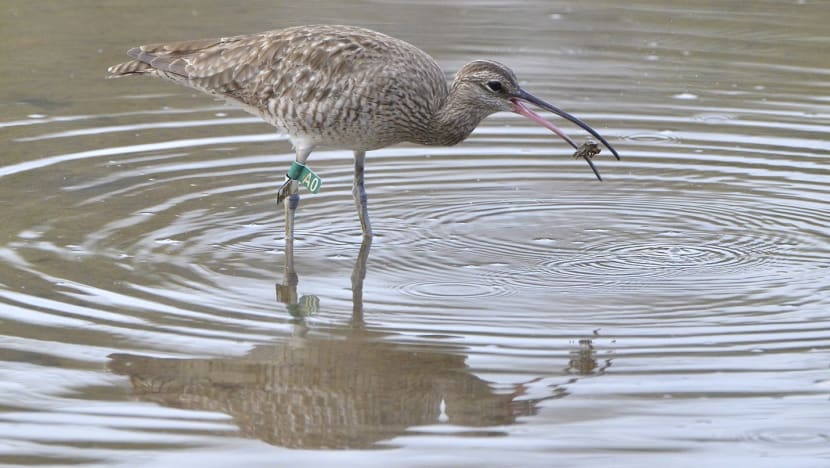Commentary: The thrill of birdwatching while grounded by the pandemic
More people are looking skywards in Singapore, leading to a record number of rare bird sightings in 2021. No wonder when birdwatching has something to offer for everyone, says volunteer bird surveyor Liu Xinlu.

A blue-tailed bee-eater. (Photo: YK Han)
SINGAPORE: Before first light, we are on our way to the north-east most corner of Singapore – Kranji Marshes.
We position ourselves in a hide by the water edge to observe the marsh and beyond. Above our heads, a pair of blue-tailed bee-eaters dash in and out of the tree branches. Their tail feathers open and close, reflecting rich iridescent colours.
In the distance, between the undulating green grass and the blue sky, there is a mid-sized white bird with black wingtips. Suddenly something remarkable happens: Its wings stiffen and flutter, and it hovers in midair – telltale behavior of a black-shouldered kite.
The morning light glistening on the water surface is punctuated by the shadow of a small flock of egrets.
In this moment, it is easy to forget that we are a stone-throw away from a bustling metropolis. We are completely immersed in the sights, sounds and smells of the marshes.

This is a typical Saturday morning for a birdwatcher (also known as birder). Since the onset of the pandemic, birding has become popular as more pick up new hobbies or spend time outdoors.
2021 has also seen a doubling of rare bird sightings in Singapore. The cinereous vulture winding up at Singapore Botanic Gardens made national news, spurring public interest in birdwatching.
Experts say reasons for the increase in sightings include changing migration patterns, climate change or simply because there are more birders in the field.
So why are so many people into birding now?
AN ACCESSIBLE AND ENRICHING HOBBY
Birdwatching is one of the most inclusive sports. No matter your physical abilities or birding skills, whether you prefer hiking 20km or waiting out in one spot, with or without equipment, birding is a fantastic way to experience nature, at your own pace, and on your own terms.
Living in Singapore, it is likely you have heard the distinctive “koo-ooo” call first thing in the morning rousing you from your sleep. Through birding, you’ll learn this morning alarm has a name – the Asian koel.
The wake-up call might not be pleasant for some, but now you start to appreciate the importance of the call to the bird, as they use it to attract mates and establish territory.
Birding enriches the mundane as you start to recognise the birds that live among us. On your morning commute, you might catch glimpses of the collared kingfisher, black-naped oriole and yellow-vented bulbul – common birds in urban Singapore.
Many birders are thrilled by the competitive nature of the sport, working to perfect their field identification skills and ecological knowledge.
Some birders also build a list of all the species they’ve spotted – just as how some people love collecting childhood trinkets, stamps or Pokémon. Many find adding a lifer (a first-time sighting) exceptionally exhilarating, as it often entails exploring new places or picking up an elusive bird in a familiar place.
STRONG LOCAL BIRDING COMMUNITY
As the pandemic continues to ground many of us, more have been looking skywards. Local birding groups on Facebook, such as Bird Sightings and Singapore Bird Group, are now followed by thousands.
Like other shared interests, birding creates a common language and breaks down barriers between people. Members swap sightings, behaviour observation notes, photos and sound recordings online. This creates a sense of togetherness – something valuable when people cannot be together physically.
Birdwatching events help the community grow too. The Singapore Bird Race, the annual go-to event for birdwatchers, attracted 230 entrants in 2021, almost twice the number of participants in pre-pandemic years.

Held annually by the Nature Society Singapore since 1984, the Singapore Bird Race is among the longest-running citizen science events in Southeast Asia to promote the appreciation, awareness and conservation of wild birds in Singapore.
During the race, birdwatchers come together and vie for who can see (or photograph) the greatest number of species within a window of time. Teams conduct surveillance of the sites, strategise where and when to go to maximise the total number of birds they see, before entering the race in earnest.
The event doesn’t just appeal to veteran birders – it is open to all as it includes categories such as Novice, Family and Youth.
Besides the Bird Race, it’s easy to get acquainted with the local birding community thanks to citizen science programmes organised by the National Parks Board, which include Garden Bird Watch, Heron Watch and Shorebird Sighting Records. Volunteers collect island-wide data on the abundance and distribution of birds, helping monitor the health of bird populations and surveyed sites.
Those who sign up receive training on bird identification and survey, which often bloom into a full passion for birdwatching. This is how many get started on birding, including me.
TRAVELLING THE WORLD THROUGH MIGRATORY BIRDS
Birdwatching also offers an avenue to transverse the world. During a time of restricted travel, who can be better ambassadors for wanderlust than our winged friends?
Wintering migrants, such as whimbrels and sandpipers that visit Singaporean shores between September and March, signal the passage of seasons which we would not otherwise feel on our tropical island
Sungei Buloh Wetland Reserve is a popular stopover between the north and southern hemispheres for many migratory waterbirds. With many mudflats offering sumptuous feasts, Sungei Buloh attracts birds as far north as Europe, Siberia or Alaska.
The feat of migration inspires awe in the great strength and stamina of birds, but also an appreciation for how interconnected global ecosystems are. Habitat loss, particularly along the migratory flyways, coupled with illegal poaching and climate change, are threatening the fate of these birds.
The effects have been seen here. According to research group BirdLife International, the curlew sandpiper and long-toed stint populations observed in Singapore have declined by 25 to 50 per cent over the past decade, likely because of dwindling coastal wetlands and large-scale hunting along their migratory route in East and Southeast Asia.
Fortunately, there are still reasons for optimism as scientists and governments work to protect biodiversity hotspots. In Sungei Buloh, conservationists tag shorebirds with bands or satellite trackers to monitor their travelling patterns.

These tracking efforts have also contributed to the Government’s decision to conserve Mandai Mudflat as a nature park. The research has confirmed that Mandai Mudflat, 3km away from Sungei Buloh, is ecologically linked to it, as many shorebirds roosting in Sungei Buloh use Mandai’s extensive mudflat as foraging ground during low tide.
Birdwatching is ultimately not just about birds. It is a medium through which we can interact with and experience the world. When we are out birding, we marvel at the elegance and resourcefulness of birds, in between enjoying the breeze through the trees and the solitude of nature.
Conservationist Aldo Leopold said, “There are some who can live without wild things, and some who cannot.” I hope that with the growing community of birders in Singapore, we’ll be invested in the future of birds and the habitats we share, for the sake of the wild things.
Liu Xinlu is a sustainability consultant, scuba diver and volunteer bird surveyor.




















